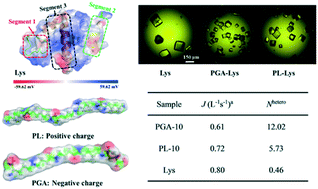Charged polymeric additives affect the nucleation of lysozyme crystals†
Abstract
The negatively charged poly-γ-glutamic acid (PGA) and the positively charged poly-ε-lysine (PL) were studied as biopolymer additives to modulate the structure of lysozyme crystals, to determine the effects of electrostatic interactions on protein crystallization. Characterized using circular dichroism, dynamic light scattering, Fourier-transform infrared spectroscopy, powder X-ray diffraction, and so on, it was found that the charged polymeric additives can facilitate the heterogeneous nucleation of lysozyme. PGA can promote the formation of more crystals than PL at a low concentration of lysozyme (5 mg mL−1), and both additives reduce the homogeneous nucleation rate but greatly enhance the heterogeneous nucleation of lysozyme. Three segments of lysozyme, with individual local charges of neutral, negative and positive, were selected to study the probable interaction modes between the lysozyme and the additives using molecular modeling. This study shows that the binding strength of PGA decreases in the order of the sites SEG1 > SEG3 > SEG2, suggesting that PGA molecule can paste around lysozyme like a necklace way. It is suggested that adjusting the suitable conformational structures of protein molecules using electrostatic interactions of biocompatible polymers can promote the formation of the ordered nucleus for protein crystallization.



 Please wait while we load your content...
Please wait while we load your content...